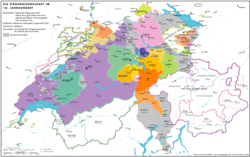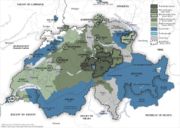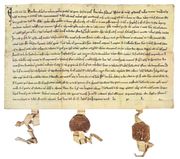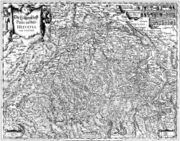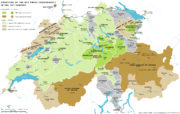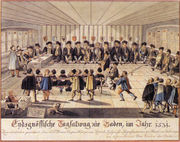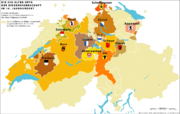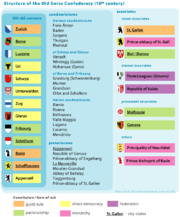Old Swiss Confederacy
2008/9 Schools Wikipedia Selection. Related subjects: General history
|
|||||||||||||||||||||||||||||||||
| History of Switzerland | |
|---|---|
| Early history | (before 1291) |
| Old Swiss Confederacy | |
| Growth | ( 1291– 1516) |
| Reformation | ( 1516– 1648) |
| Ancien Régime | ( 1648–1798) |
| Transitional period | |
| Napoleonic era | (1798–1814) |
| Restauration | (1814–1847) |
| Switzerland | |
| Federal state | (1848–1914) |
| World Wars | (1914–1945) |
| Modern history | (1945–present) |
| Topical | |
| Military history | |
The Old Swiss Confederacy was the precursor of modern-day Switzerland. The Swiss Eidgenossenschaft, as the confederacy was called, was a loose federation of largely independent small states that existed from the late 13th century until 1798, when it was invaded by the French Republic, who transformed it into the short-lived Helvetic Republic.
History
The nucleus of the Old Swiss Confederacy was an alliance between the communities of the valleys in the Central Alps to facilitate the management of common interests such as free trade and to ensure the peace along the important trade routes through the mountains. The Federal Charter of 1291 among the rural communes of Uri, Schwyz, and Unterwalden is traditionally considered the founding document of the confederacy, although similar alliances may have existed already a few decades earlier.
Growth of the federation
This initial pact was gradually augmented with additional pacts with the cities of Lucerne, Zürich, and Berne. This rare union of rural and urban communes, all of which had the status of imperial immediacy within the Holy Roman Empire, was caused by them all being under pressure by the Habsburg dukes and kings, who once had ruled much of these lands. In several battles against Habsburg armies, the Swiss remained victorious and even conquered the rural areas of Glarus and Zug, which became independent members of the confederacy, too.
From 1353 to 1481, this federation of eight cantons, known in German as the Acht Orte (Eight Places), consolidated its position. The individual members, especially the cities, enlarged their territories at the cost of the local counts in the neighbourhood, mostly by buying the judicial rights, but sometimes also by force. The Eidgenossenschaft as a whole expanded through military conquests. The Aargau was conquered in 1415, the Thurgau in 1460. Both times, the Swiss profited from a weakness of the Habsburg dukes. In the south, Uri led a military territorial expansion that would—after many setbacks—by 1515 lead to the conquest of the Ticino. None of these territories became members of the confederacy, though; instead, they had a status as condominiums, regions administered commonly by several cantons.
At the same time, the eight cantons gradually increased their influence on neighbouring cities and regions through additional alliances. Not the Eidgenossenschaft as a whole, but several (or only one) individual cantons concluded pacts with Fribourg, Appenzell, Schaffhausen, the abbot and the city of St. Gallen, Biel, Rottweil, Mulhouse, and others. These allies, called the Zugewandte Orte, became closely associated to the confederacy, but were not accepted as full members.
The Burgundy Wars prompted a further enlargement of the union with new members. Fribourg and Solothurn were accepted into the confederacy in 1481. In the Swabian War against emperor Maximilian I, Holy Roman Emperor, the Swiss again remained victorious and were exempted from the imperial legislation. The previously associated cities of Basel and Schaffhausen joined the confederacy as a direct result of that conflict. Appenzell followed in 1513 as the 13th member. This federation of thirteen cantons (Dreizehn Orte) constituted the Old Swiss Confederacy until its demise in 1798.
The military expansion of the confederacy was stopped by the loss of the Swiss in the battle of Marignano in 1515. Only Berne and Fribourg were still able to conquer the Vaud in 1536, which mostly became part of the canton of Berne, with only a small part coming under the rule of Fribourg.
Confessional confusions
The Reformation in Switzerland led to a confessional division amongst the cantons. Zürich, Berne, Basel, Schaffhausen, as well as the associates Biel, Mulhouse, Neuchâtel, Geneva, and the city of St. Gallen became Protestant, the other members of the confederation and the Valais remained Catholic. In Glarus, Appenzell, in the Grisons, and in most condominiums both religions coexisted; Appenzell split in 1597 into a Catholic Appenzell Inner Rhodes and a Protestant Appenzell Outer Rhodes.
The confessional division led to civil war — the wars of Kappel — and separate alliances with foreign powers of the Catholic and Protestant factions, but the confederacy as a whole continued to exist. A common foreign policy was blocked, though, by the stand-off of the two equally strong camps. In the Thirty Years' War, the deep religious disagreements among the cantons kept the confederacy neutral and spared it from all belligerent devastations. At the Peace of Westphalia, the Swiss delegation was granted formal recognition of the confederacy as an independent state, separate from the Holy Roman Empire.
Growing social differences and an increasing absolutism in the city cantons during the Ancien Régime of Switzerland led to various local popular revolts. Only the uprising in 1653 during the post-war depression after the Thirty Years' War escalated to the general Swiss peasant war in the territories of Lucerne, Berne, Basel, Solothurn, and in the Aargau. The revolt was put down by force with the help of the other cantons.
The religious differences were increasingly accentuated by an ever-growing economic discrepancy. The Catholic and predominantly rural central Swiss cantons were surrounded by Protestant cantons with a flourishing economy that slowly became industrialised. The politically dominant cantons were Zürich and Berne, both Protestant, but in the common agencies of the confederation, the Catholic cantons had the upper hand since the second war of Kappel in 1531. An attempt in 1655, led by Zürich, to restructure the federation was blocked by a Catholic opposition, which led to the first war of Villmergen in 1656, which the Catholic party won, cementing the status quo. But the problems remained unsolved and erupted again in 1712 in the second war of Villmergen. This time, the Protestant cantons won, and henceforth dominated the federation. A true reform, however, was not possible: the individual interests of the thirteen members were too diverse and the absolutist cantonal governments resisted all attempts at centralisation or at introducing a federation-wide administration or a modern bureaucracy. The foreign politics remained fragmented.
In 1798, the confederacy was invaded by the troops of Napoleon I. It succumbed with only insignificant resistance against the French armies. The Ancien Régime and the Old Swiss Confederacy were replaced by the Helvetic Republic by grace of Napoleon.
Structure of the federation
Initially, the Eidgenossenschaft was not united by one single pact, but rather by a whole set of overlapping pacts and separate bilateral treaties between various members, with only minimum liabilities. The parties generally agreed to preserve the peace in their territories, help each other in military endeavours, and defined some arbitration in case of disputes. Only slowly did the members begin to understand the federation itself as a unifying entity. In the Pfaffenbrief, a treaty of 1370 among six of the eight members (Glarus and Berne did not participate) that forbade feuds and that denied clerical courts any jurisdiction over the confederacy, the cantons referred for the first time to themselves using the singular term Eidgenossenschaft. The first treaty uniting all of the then eight members of the confederacy became the Sempacherbrief of 1393. This treaty was concluded after the important victories over the Habsburgs at Sempach and Näfels (1386 and 1388) and defined that no member was to unilaterally begin a war without the consent of the other cantons. Subsequently, a kind of federal diet, the Tagsatzung, developed in the 15th century.
Other pacts and renewals or modernizations of earlier alliances between some of the members reinforced the confederacy. Yet the individual interests of the cantons clashed in the Old Zürich War (1436 – 1450), which was caused by a territorial conflict among Zürich and the central Swiss cantons over the succession of the Count of Toggenburg. Zürich even entered an alliance with the Habsburg dukes, but finally re-joined the confederacy. The confederation had grown into a political alliance so close that it no longer tolerated separatist tendencies of its members.
The Tagsatzung served as the council of the confederation and typically met several times a year. Each canton delegated two representatives; including the associate states, who, however, had no vote. Initially, the canton where the delegates met chaired the gathering, but in the 16th century, Zürich permanently assumed the chair (Vorort), and Baden became the sessional seat. The Tagsatzung dealt with all inter-cantonal affairs and also served as the final arbitral court to settle disputes between member states, or to decide on sanctions against dissenting members. It also organized and oversaw the administration of the condominiums; the reeves were delegated for two years, each time by a different canton.
An important unifying treaty of the Old Swiss Confederacy was the Stanser Verkommnis of 1481. Conflicts between the rural and the urban cantons and disagreements about the repartition of the bounty of the Burgundian Wars had led to several skirmishes. The city states of Fribourg and Solothurn wanted to join the confederacy, but were met with distrust by the central Swiss rural cantons. The compromise of the Tagsatzung in the Stanser Verkommnis restored order and accounted for the rural cantons' complaints; Fribourg and Solothurn were accepted into the federation. While the treaty also restricted the freedom of assembly (many skirmishes were caused by unauthorised expeditions of groups of soldiers from the Burgundian Wars), it also reinforced the agreements amongst the cantons of the earlier Sempacherbrief and Pfaffenbrief.
The civil war during the Reformation brought about a stalemate. The victorious Catholic cantons could block any decisions of the council, but due to their geographic and economic situation could not overcome the Protestant cantons. Both factions began to hold separate councils, but still met at a common Tagsatzung, even though this common council remained effectively blocked by the disagreements of the two factions until 1712, when the Protestant cantons reversed the situation after their victory in the second war of Villmergen. The Catholic cantons were excluded from the administration of the condominiums in the Aargau, the Thurgau, and the Rhine valley; in their place, Berne became a co-sovereign of these regions.
Cantons
The confederation expanded in several stages: first to the Eight Places (Acht Orte), then in 1481 to ten, in 1501 to twelve, and finally to thirteen cantons (Dreizehnörtige Eidgenossenschaft).
 Uri, rural canton, since 1291
Uri, rural canton, since 1291 Schwyz, rural canton, since 1291
Schwyz, rural canton, since 1291 Unterwalden, rural canton, since 1291
Unterwalden, rural canton, since 1291 Lucerne, city canton, since 1332
Lucerne, city canton, since 1332 Zürich, city canton, since 1351
Zürich, city canton, since 1351 Glarus, rural canton, since 1352
Glarus, rural canton, since 1352 Zug, city canton, since 1352
Zug, city canton, since 1352 Berne, city canton, since 1353; associate since 1323
Berne, city canton, since 1353; associate since 1323 Fribourg, city canton, since 1481; associate since 1454
Fribourg, city canton, since 1481; associate since 1454 Solothurn, city canton, since 1481; associate since 1353
Solothurn, city canton, since 1481; associate since 1353 Basel, city canton, since 1501
Basel, city canton, since 1501 Schaffhausen, city canton, since 1501; associate since 1454
Schaffhausen, city canton, since 1501; associate since 1454 Appenzell, rural canton, since 1513; associate since 1411
Appenzell, rural canton, since 1513; associate since 1411
Associates
Associates (Zugewandte Orte) were close allies of the Old Swiss Confederacy, connected to the union by alliance treaties with all or some of the individual members of the confederacy.
Closest associates
Three of the associates were known as Engere Zugewandte:
 Biel — 1344–82 treaties with Fribourg, Berne and Solothurn. Nominally, Biel was subject to the Bishopric of Basel.
Biel — 1344–82 treaties with Fribourg, Berne and Solothurn. Nominally, Biel was subject to the Bishopric of Basel. Imperial Abbey of St. Gallen — 1451 treaty with Schwyz, Lucerne, Zürich and Glarus, renewed in 1479 and 1490. The abbey was simultaneously a protectorate.
Imperial Abbey of St. Gallen — 1451 treaty with Schwyz, Lucerne, Zürich and Glarus, renewed in 1479 and 1490. The abbey was simultaneously a protectorate. Imperial City of St. Gallen — 1454 treaty with Schwyz, Lucerne, Zürich, Glarus, Zug and Berne.
Imperial City of St. Gallen — 1454 treaty with Schwyz, Lucerne, Zürich, Glarus, Zug and Berne.
Eternal associates
Two federations were known as Ewige Mitverbündete:
 Sieben Zenden, an independent federation in the Valais — Became a Zugewandter Ort in 1416 through an alliance with Uri, Unterwalden and Lucerne, followed by a treaty with Berne in 1446.
Sieben Zenden, an independent federation in the Valais — Became a Zugewandter Ort in 1416 through an alliance with Uri, Unterwalden and Lucerne, followed by a treaty with Berne in 1446. Three Leagues were independent federations on the territory of the Grisons and became an associates of the Old Swiss Confederacy in 1497/98 through the events of the Swabian War. The Three Leagues together concluded an alliance pact with Berne in 1602.
Three Leagues were independent federations on the territory of the Grisons and became an associates of the Old Swiss Confederacy in 1497/98 through the events of the Swabian War. The Three Leagues together concluded an alliance pact with Berne in 1602.  Grey League, who had been allied with Glarus, Uri and Obwalden through pacts from 1400, 1407 and 1419, entered an alliance with seven of the old eight cantons (the Acht Orte without Berne) in 1497
Grey League, who had been allied with Glarus, Uri and Obwalden through pacts from 1400, 1407 and 1419, entered an alliance with seven of the old eight cantons (the Acht Orte without Berne) in 1497 League of God's House (Gotteshausbund) followed suit a year later.
League of God's House (Gotteshausbund) followed suit a year later. League of the Ten Jurisdictions, the third of the leagues, entered an alliance with Zürich and Glarus in 1590.
League of the Ten Jurisdictions, the third of the leagues, entered an alliance with Zürich and Glarus in 1590.
Protestant associates
There were two Evangelische Zugewandte:
 Imperial City of Mulhouse — Concluded a first treaty with some cantons in 1466 and became an associate in 1515 through a treaty with all 13 members of the Confederacy, remaining so until events of the French Revolutionary Wars in 1797.
Imperial City of Mulhouse — Concluded a first treaty with some cantons in 1466 and became an associate in 1515 through a treaty with all 13 members of the Confederacy, remaining so until events of the French Revolutionary Wars in 1797. Imperial City of Geneva — 1536 treaty with Berne and a 1584 treaty with Zürich and Berne.
Imperial City of Geneva — 1536 treaty with Berne and a 1584 treaty with Zürich and Berne.
Remaining associates
 County of Neuchâtel — 1406 and 1526 treaties with Berne and Solothurn, 1495 treaty with Fribourg and 1501 treaty with Lucerne.
County of Neuchâtel — 1406 and 1526 treaties with Berne and Solothurn, 1495 treaty with Fribourg and 1501 treaty with Lucerne. Imperial Valley of Urseren — 1317 treaty with Uri; annexed by Uri in 1410.
Imperial Valley of Urseren — 1317 treaty with Uri; annexed by Uri in 1410. Weggis — 1332–1380 by treaties with Uri, Schwyz, Unterwalden and Lucerne; annexed by Lucerne in 1480.
Weggis — 1332–1380 by treaties with Uri, Schwyz, Unterwalden and Lucerne; annexed by Lucerne in 1480. Murten — from 1353 by treaty with Berne; became a confederal condominium in 1475.
Murten — from 1353 by treaty with Berne; became a confederal condominium in 1475. Payerne — from 1353 by treaty with Berne; annexed by Berne in 1536.
Payerne — from 1353 by treaty with Berne; annexed by Berne in 1536. Vogtei of Bellinzona — from 1407 by treaty with Uri and Obwalden; became a confederal condominium from 1419–22.
Vogtei of Bellinzona — from 1407 by treaty with Uri and Obwalden; became a confederal condominium from 1419–22. County of Sargans — from 1437 by treaty with Glarus and Schwyz; became a confederal condominium in 1483.
County of Sargans — from 1437 by treaty with Glarus and Schwyz; became a confederal condominium in 1483. Barony of Sax-Forstegg — from 1458 by treaty with Zürich; annexed by Zürich in 1615
Barony of Sax-Forstegg — from 1458 by treaty with Zürich; annexed by Zürich in 1615 Stein am Rhein — from 1459 by treaty with Zürich and Schaffhausen; annexed by Zürich in 1484.
Stein am Rhein — from 1459 by treaty with Zürich and Schaffhausen; annexed by Zürich in 1484. County of Gruyère — had been allied with Fribourg and Berne since the early 14th century, becoming a full associate of the Confederation in 1548. When the counts fell bankrupt in 1555, the country was partitioned in twain:
County of Gruyère — had been allied with Fribourg and Berne since the early 14th century, becoming a full associate of the Confederation in 1548. When the counts fell bankrupt in 1555, the country was partitioned in twain:
 County of Werdenberg — from 1493 by treaty with Lucerne; annexed by Glarus in 1517.
County of Werdenberg — from 1493 by treaty with Lucerne; annexed by Glarus in 1517. Imperial City of Rottweil — from 1519–1632 through a treaty with all 13 members; a first treaty on military cooperation had already been concluded in 1463. In 1632, the treaty was renewed with Lucerne, Uri, Schwyz, Unterwalden, Zug, Solothurn and Fribourg.
Imperial City of Rottweil — from 1519–1632 through a treaty with all 13 members; a first treaty on military cooperation had already been concluded in 1463. In 1632, the treaty was renewed with Lucerne, Uri, Schwyz, Unterwalden, Zug, Solothurn and Fribourg. Bishopric of Basel — 1579–1735 by treaty with Lucerne, Uri, Schwyz, Unterwalden, Zug, Solothurn and Fribourg.
Bishopric of Basel — 1579–1735 by treaty with Lucerne, Uri, Schwyz, Unterwalden, Zug, Solothurn and Fribourg.
Condominiums
Condominiums (German: Gemeine Herrschaften) were common subject territories under the administration of several cantons. They were governed by reeves delegated for two years, each time from another of the responsible cantons. Berne initially did not participate in the administration of some of the eastern condominiums, as it had no part in their conquest and its interests were focused more on the western border. In 1712, Berne replaced the Catholic cantons in the administration of the Freie Ämter ("Free Districts"), the Thurgau, the Rhine valley, and Sargans, and furthermore the Catholic cantons were excluded from the administration of the County of Baden.
German bailiwicks
The "German bailiwicks" (German: Deutsche Gemeine Vogteien, Gemeine Herrschaften) were generally governed by the Acht Orte apart from Berne until 1712, when Berne joined the sovereign powers:
 Freie Ämter — conquered 1415 and partitioned in 1712:
Freie Ämter — conquered 1415 and partitioned in 1712: - Upper Freiamt was governed by the Acht Orte;
- Lower Freiamt was governed by Zürich, Berne and Glarus alone.
 County of Baden — conquered 1415; from 1712 governed by Zürich, Berne and Glarus.
County of Baden — conquered 1415; from 1712 governed by Zürich, Berne and Glarus. County of Sargans — from 1460/83
County of Sargans — from 1460/83 Landgraviate of Thurgau — from 1460
Landgraviate of Thurgau — from 1460 Vogtei of Rheintal — from 1490, Acht Orte minus Berne, plus the Imperial Abbey of St Gall. Appenzell added in 1500; Berne added in 1712.
Vogtei of Rheintal — from 1490, Acht Orte minus Berne, plus the Imperial Abbey of St Gall. Appenzell added in 1500; Berne added in 1712.
Italian bailiwicks
Several Vogteien were generally referred to as the Bailiwicks beyond the Mountains — German: Ennetbergische Vogteien, Italian: Baliaggi Ultramontani. In 1440, Uri conquered the Leventina Valley from the Visconti, dukes of Milan. Some of this territory had previously been annexed between 1403 and 1422. Further territories were acquired in 1500; see History of Ticino for further details.
Three bailiwicks, all now in the Ticino, were condominiums of the Forest cantons of Uri, Schwyz and Nidwalden:
 Vogtei of Blenio — 1477–80 and from 1495
Vogtei of Blenio — 1477–80 and from 1495 Vogtei of Rivera — 1403–22 and from 1495
Vogtei of Rivera — 1403–22 and from 1495 Vogtei of Bellinzona — from 1500
Vogtei of Bellinzona — from 1500
Four other Ticinese bailiwicks were condominiums of the Zwölf Orte (the original 13 cantons, minus Appenzell) from 1512:
Another three bailiwicks were condominiums of the Zwölf Orte from 1512, but were lost from the Confederacy three years later and are all now comuni of Lombardy:
Two-party condominiums
Vogteien of Bern and Fribourg
 County of Grasburg / Schwarzenburg — from 1423
County of Grasburg / Schwarzenburg — from 1423 Murten — from 1475
Murten — from 1475 Grandson — from 1475
Grandson — from 1475 Orbe and Echallens — from 1475
Orbe and Echallens — from 1475
Vogteien of Glarus and Schwyz
 County of Uznach — from 1437
County of Uznach — from 1437 , Lordship of Windegg / Gaster — from 1438
, Lordship of Windegg / Gaster — from 1438 Lordship of Hohensax / Gams — from 1497
Lordship of Hohensax / Gams — from 1497
Condominiums with third-parties
Protectorates
 Bellelay Abbey — protectorate of Bern, Biel and Solothurn from 1414; nominally under the jurisdiction of the Bishopric of Basel
Bellelay Abbey — protectorate of Bern, Biel and Solothurn from 1414; nominally under the jurisdiction of the Bishopric of Basel Einsiedeln Abbey — protectorate of Schwyz from 1357
Einsiedeln Abbey — protectorate of Schwyz from 1357 Engelberg Abbey — protectorate of Lucerne, Uri, Schwyz and Unterwalden from 1425
Engelberg Abbey — protectorate of Lucerne, Uri, Schwyz and Unterwalden from 1425 Erguel — protectorate of Biel under military jurisdiction from 1335; also subject to the Bishopric of Basel
Erguel — protectorate of Biel under military jurisdiction from 1335; also subject to the Bishopric of Basel Imperial Abbey of St. Gallen — protectorate of Schwyz, Lucerne, Zürich and Glarus from 1451; the abbey was simultaneously a Zugewandter Ort.
Imperial Abbey of St. Gallen — protectorate of Schwyz, Lucerne, Zürich and Glarus from 1451; the abbey was simultaneously a Zugewandter Ort. Republic of Gersau, an independent village — allied with Schwyz since 1332; Lucerne, Uri and Unterwalden were also protecting powers.
Republic of Gersau, an independent village — allied with Schwyz since 1332; Lucerne, Uri and Unterwalden were also protecting powers. Moutier-Grandval Abbey — protectorate of Berne from 1486; the abbey was also subject to the Bishopric of Basel and, until 1797, the Holy Roman Empire
Moutier-Grandval Abbey — protectorate of Berne from 1486; the abbey was also subject to the Bishopric of Basel and, until 1797, the Holy Roman Empire La Neuveville — protectorate of Berne from 1388; also subject to the Bishopric of Basel.
La Neuveville — protectorate of Berne from 1388; also subject to the Bishopric of Basel. Pfäfers Abbey — protectorate of the Acht Orte minus Berne from 1460; annexed to the County of Sargans in 1483
Pfäfers Abbey — protectorate of the Acht Orte minus Berne from 1460; annexed to the County of Sargans in 1483 Rapperswil — protectorate of Uri, Schwyz, Unterwalden and Glarus from 1464; of Zürich, Berne and Glarus from 1712
Rapperswil — protectorate of Uri, Schwyz, Unterwalden and Glarus from 1464; of Zürich, Berne and Glarus from 1712 County of Toggenburg — protectorate of Schwyz and Glarus from 1436; of Zürich and Berne from 1718. The county was simultaneously subject to St Gallen Abbey.
County of Toggenburg — protectorate of Schwyz and Glarus from 1436; of Zürich and Berne from 1718. The county was simultaneously subject to St Gallen Abbey.
Separate subjects
Some territories were separate subjects of cantons or associates, Einzelörtische Untertanen von Länderorten und Zugewandten:
of Uri
of Schwyz
of Glarus
of the Republic of Valais
 St-Maurice (1475 / 77)
St-Maurice (1475 / 77) Monthey (1536)
Monthey (1536) Nendaz-Hérémance (1475 / 77)
Nendaz-Hérémance (1475 / 77) Port Valais/Vionnaz
Port Valais/Vionnaz Lötschental (15th century); the five upper Zenden
Lötschental (15th century); the five upper Zenden
of the Three Leagues
 Bormio (1512)
Bormio (1512) Chiavenna (1512)
Chiavenna (1512) Valtellina (1512)
Valtellina (1512) Drei Pleven (1512–26)
Drei Pleven (1512–26) Maienfeld ( Bündner Herrschaft) (1509–1790); simultaneously a member of the League of the Ten Jurisdictions.
Maienfeld ( Bündner Herrschaft) (1509–1790); simultaneously a member of the League of the Ten Jurisdictions.
